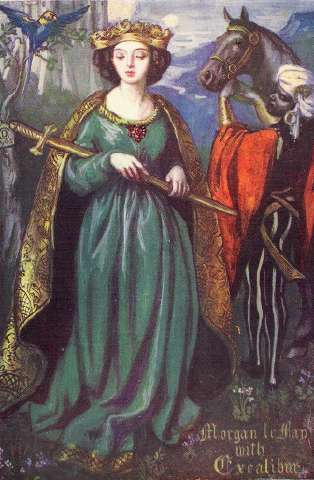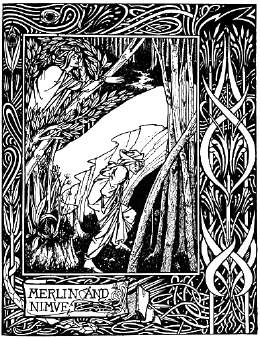 - Do YOU believe in Færies? That may seem an odd question (well, depends who your friends are!). If not, then suspend disbelief for the duration of this article. Morgen is a classic case of literary split personality.
- Do YOU believe in Færies? That may seem an odd question (well, depends who your friends are!). If not, then suspend disbelief for the duration of this article. Morgen is a classic case of literary split personality.
In the usual versions of the Arthurian legend, she is Arthur's half-sister, a witch who schemes to destroy him. In some modern versions, including Marion Zimmer Bradley's deeply Californian The Mists of Avalon and the film Excalibur, she is Mordred's mother. And yet - traditionally, she is supposed to be the leader of the Queens who come to take Arthur away by boat. A trifle inconsistent? Well, yes, it would be - if she were a human being... But she isn't.
The name Malory gives her says it all: Morgan le Fay - i.e., the Færie (Malory always has trouble with the gender of the French definite article!). Færies are notoriously capricious beings, benign and malevolent at will. So how did Arthur get a færie as his half-sister?
Morgen was not originally related to Arthur at all; this is a later development, found in the French romances, which diluted her powers to those of a human enchantress. She first appears in Geoffrey of Monmouth's Life of Merlin as the chief of 9 sisters on the Island of Avalon, whither the wounded Arthur is brought for healing. Layamon, a 12 C. priest writing in English, calls her "the fairest of elves". It's Chrétien de Troyes who makes her Arthur's sister.
Morgen's name (morigena = sea-born) and island home link her with the Breton sea-færies - morgans, or mari-morgans, and she has other links with water. The healing shrine of 9 sisters and the name of Avalon - originally Afallach - point in another direction, as the 14 C. author of Gawaine and the Green Knight realised as he called her "goddess".
 In Kildare, and probably in other places, there was a healing shrine kept by 9 sisters. Its goddess was known by an epithet, 'The High/Exalted One' - Brigid, known in mainland Britain as 'Brigantia', patron of the NE tribe, the Brigantes, of healing, inspiration and smithcraft. The happy concidence of her title with the name of a Dark Age abbess allowed her cult to be hijacked by Christians. She is still associated with healing springs and wells, as in St. Bride's Well in St. Andrews.
In Kildare, and probably in other places, there was a healing shrine kept by 9 sisters. Its goddess was known by an epithet, 'The High/Exalted One' - Brigid, known in mainland Britain as 'Brigantia', patron of the NE tribe, the Brigantes, of healing, inspiration and smithcraft. The happy concidence of her title with the name of a Dark Age abbess allowed her cult to be hijacked by Christians. She is still associated with healing springs and wells, as in St. Bride's Well in St. Andrews.
'Afallach' is another clue. Y Troiedd refer to 'Modron ferch Afallach' - The Great Mother, daughter of Afallach - as, in some sense, wife of Urien of Rheged. A folk-tale tells how Urien met Modron, daughter of the King of the Otherworld, as Washer at the Ford, and bedded her, having two children by her. In later mediæval tradition, 'King Uriens' is husband of Morgan le Fay. Is Morgen to be identified, then, with Modron, the Great Mother of the Rivers - the same Matrona depicted in triple form in Romano-Gallic sculptures, who gave her name to the Marne? - It seems likely. They share a father, Afallach, whose island is clearly an Otherworld for fallen heroes. If she were tutelary Goddess of Rheged, she could be symbolically wedded to its King, and be 'mother' to his children. In The Dream of Rhonabwy, Owain mab Urien, her human 'son', is associated with ravens - symbols of the Mother in her aspect as war-goddess (in Irish, the Morrigan, or 'Great Queen').
Modron's divine son leads us to another aspect of her identity. The Great Mother's child is the Great Son, Mabon, the 'Apollo Maponus' of the Roman Occupation. In Brythonic tradition, Mabon is remembered as a prisoner, taken from his mother when three nights old. In Culhwch and Olwen, he is rescued by Kei and Bedwyr after they consult the Oldest Animals,and assists them in hunting the magical boar Trwyth. Mabon appears as Mabuz, a prisoner in an enchanted castle, in Ulrich von Zatzikhoven's Lanzelet (Swiss, 1190s, probably based on Norman material from Breton sources). Mabuz is the son of the færie who brought up Lancelot (Ulrich gives what may be Lancelot's original story - that of a boy raised by færies, who has to rescue his faerie foster-mother - no romance with Guenevere). This is the lady later known as the Lady of the Lake and also credited with healing Arthur...
You see where this is leading us back?
The Lady of the Lake and Morgen were one and the same. They developed separate identities as Morgen became increasingly identified as Arthur's human sister and acquired hostile characteristics at the hands of the French romancers. In the same way, the Lady of the Lake (sometimes called Nimue) was split up by Tennyson, because of the ambivalence of her behaviour. He made the aspect of her which destroyed Merlin into the separate, cynical human Vivien. But færies in Celtic tradition are ambiguous creatures, outside human systems of morality. And the Lady is more than a færie, anyway.
I have referred to her by her epithets - 'the Exalted', 'the Sea-Born', 'the Great Mother': perhaps there is a diluted trace of her in the Catholic hymn Ave Maris Stella - 'Hail, Star of the Sea' - and some folk-memories in the Virgins of the Springs at places like Knock and Lourdes. She is the Matriarch of the Gods. The Celts gave her personal name as Dôn or Danu, which takes us back along all the rivers of our Indo-European language-family's migrations: the Dons of Aberdeenshire, Yorkshire and Russia, the Danube, the Dneiper, the Dneister and many others, and also into India. For Danu is, in Vedic Hinduism, the Goddess of the Primordial Waters. She unites us, East and West: the force from whom all life flows, and to whom it returns.


